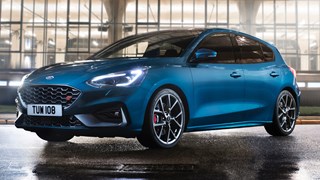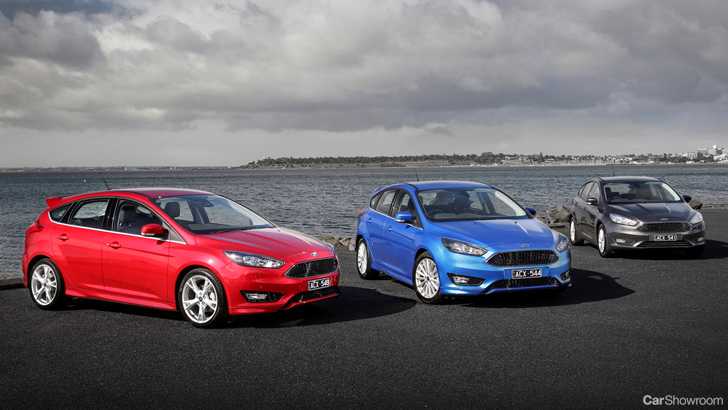We’re not alone in ranking the Ford Focus amongst the very best of the current small cars. Lots of kit, handy to drive, sharply priced and beautifully made, the Focus is in our minds on the same page as the Mazda3 and has been for some time.
Yes it’s that good.
Now Ford has launched the updated MkII Focus with a new turbocharged 1.5-litre engine, freshened looks and improved chassis plus even better levels of standard equipment and technology. Ford says most of the updates for the Focus came from customer feedback.
Focus joined the Ford family generations ago in 1998 and since then has become one of Ford’s biggest sellers with more than 12 million vehicles sold in more than 140 global markets. Focus is now made in eight Ford plants around the world and chalks-up more than 1.0 million sales annually.
Ford Focus Overview
Ford has altered the Focus model grades (entry-level Ambiente has been ditched so Trend now opens the batting). And with no diesel engine, it’s a simpler range with seven models.
So now the opening shot for Ford Focus, the Trend model, is impressively well-equipped with standard features such as 16-inch alloy wheels, DRLs, fog-lights, fuel-saving active grille shutters, hill launch assist, rear parking sensors, rear-view camera, cruise control and satellite navigation.
Stepping up to the Sport model adds some handy extras such as 17-inch alloy wheels, sports tuned suspension, rear LED lights and LED DRLs, sports bodykit (rear spoiler, side skirts front/rear aprons), keyless entry/pushbutton start, leather-wrapped steering wheel and gear-lever, dual-zone climate control air-conditioning, auto headlights and wipers and a nine-speaker Sony audio system.
Range-topping Titanium gets the whole enchilada, adding 18-inch alloy wheels, front parking sensors, leather-trimmed sports seats and the technology suite (blind spot information with rear cross traffic alert, enhanced active park assist - parallel or perpendicular parking - and active city stop).
The updated lineup is:
| Variant | Hatchback | Sedan |
| Trend (manual) | $23,390 | - |
| Trend (automatic | $24,390 | $24,390 |
| Sport (manual) | $26,490 | - |
| Sport (automatic) | $27,490 | - |
| Titanium (automatic) | $32,690 | $32,690 |
Ford Focus Engine
Probably the biggest news for the updated Ford Focus is the switch to a new turbocharged 1.5-litre, four-cylinder engine. The new powerplant is both more powerful and more fuel-efficient than the previous naturally-aspirated 1.6-litre.
It’s from Ford’s EcoBoost family so that means turbocharging, direct fuel-injection, twin independent variable valve timing and a lightweight aluminium block. There’s also some technology sourced from Ford’s award-winning 1.0-litre, three-cylinder engine in the form of a new cylinder head design with integrated exhaust manifold for reduced turbo lag.
All that adds-up to 134kW of power and 240Nm of torque which places the updated Ford Focus up with the Mazda3 SP25 and Nissan Pulsar SSS for the title of the most powerful small car in Australia. Combined-cycle fuel consumption is rated at 5.8l/100kms for the manual Trend and Sport models, 6.2l/100kms for the Trend and Sport automatics and 6.4l/100kmsfor the Titanium automatic.
Another big change is the transmission. The previous generation Ford Focus ran a dual-clutch automatic but, in the pursuit of enhanced refinement, this has been replaced by a six-speed conventional torque-converter automatic.
Ford Titanium Trend and Sport models can be had with a six-speed manual transmission.
Ford Focus The Interior
Customer feedback was the prime driver for the updated Ford Focus interior. The feedback was the previous generation was just too complex so more intuitive controls and fewer switches were called for (clearly these Ford customers haven’t seen the interior of the new Holden Astra which resembles the cockpit of a Boeing 747 with myriad switches, dials and buttons).
So we have a revised dashboard and centre stack with simpler instruments, controls and buttons and nice pale blue graphics. There’s also a new centre console with an adjustable slider to secure different size cups/bottles and a re-designed glovebox.
Some new chrome highlights also lift the interior ambience.
Ford Focus Exterior & Styling
Australian Todd Willing (the man responsible for styling the all-new Ford GT) is the company’s Design Director for Asia-Pacific. Of the updated Ford Focus he said: “We wanted to evolve and tighten the existing design to push it forward without changing character.”
Under that brief the updated Ford Focus is sleeker, bolder and more contemporary. But it’s still unmistakably a Focus.
In fact, as a quirk of global product timings, the updated Focus becomes the last Ford to score the corporate trapezoidal front grille. That headlines a more athletic front-end which also gains slim laser-cut headlights, rectangular fog lights, new DRLs, and a new bonnet and front fenders to suit.
At the rear, laser brazing has enabled a new tailgate design which is more sophisticated and works well with new, thinner tail-lights. Spoilers too are new (a larger size for Sport models).
Ford Focus On The Road
Ford ushered us onto the roads from the Adelaide CBD and out into the country inland for the national media preview. No Ford Focus sedans to drive (they arrived as bit too late to be registered etc) but www.carshowroom.co.au did get behind the wheel of all model grades (Trend, Sport and Titanium).
Under the umbrella of ‘enhanced fun to drive’ Ford’s engineers have brought to play major changes underneath the updated Focus. We’re talking new lower control arm bushes for the front suspension, a new 25 per-cent stiffer rubber compound for the rear lower control arm bushes, re-programmed electronic power steering and new strut valving.
Then there is ETS (Enhanced Transitional Stability) – a clever system which monitors speed and steering inputs to predict a loss of traction. This then activates the ESP system to reduce power and apply braking to individual wheels.
Naturally the headline act is the new turbocharged 1.5-litre engine. It is a pearler with plenty of punch across the range and a nice exhaust note when pushed hard.
All of the cars we drove were automatics and of course that too has changed to a conventional six-speed torque converter. We had no complaints about the previous model’s dual-clutch auto but Ford says the change was brought about by customer feedback and improved refinement.
So the sum total of all of that plus the extra sound deadening (front wheelarches and door inners, thicker glass and carpets) means this updated Ford Focus is a significantly better drive than the previous generation. And that’s impressive given the predecessor ranked as one of the best small cars.
We headed out through the Adelaide CBD and in the brief stop-start traffic which South Aussies call a ‘peak hour’ the smoothness of the new automatic transmission was a contrast to the sometimes balky nature of twin-clutch self-shifters. And the low-range acceleration of the turbo 1.5-litre got the www.carshowroom.com.au thumbs-up.
Into the twisty stuff however and using the gear-lever toggle switch for manual changes the six-speeder was tad slow to swap cogs. You needed to adjust your thinking on shift points to acclimatize or order paddle shifters.
In that environment the updated Ford Focus did shine with its top-notch chassis dynamics. Naturally you would need to drive old and new models back-to-back over the same piece of road to get a the full picture but there’s no doubt the updated Ford Focus is firmly in the upper echelon of small cars for driving dynamics.
Crisp steering (re-done EPAS remember), nice mid-corner balance and poise even when the throttle was nailed were the highlights. As good as the benchmark Mazda3? Yes we’re certain of that.
Ford Focus Challenges
Some of the road surfaces we encountered out of Adelaide were longing for some TLC. And on those broken surfaces the larger wheels/tyres of the Titanium model did produce noticeably extra road noise.
Ford Focus Verdict
Regular readers of www.carshowroom.com.au will know the Ford Focus rates as one of our favourite small cars. This Mk II update hits the sweetspot again.
The more powerful and fuel-efficient 1.5-litre engine kicks things off and then we have the extra equipment, sharper driving dynamics courtesy of those suspension changes and improved refinement. You can’t ask for more than that from a mid-life update.
By any measure the Ford Focus takes-on the Mazda3 for ‘best-in-segment’ honours. If you’re shopping for a small car and don’t consider the Ford Focus you made a major blunder.
Ford Focus The Competition
As we write Toyota Corolla is Australia’s best-selling car outright and while prices start from just $19,790 it pulls-up short of the Ford Focus for standard equipment. While Corolla lacks the finesse of the Ford Focus and its 103kW/173Nm naturally-aspirated 1.8-litre engine is seriously out-muscled, there’s no denying its impressive interior space and bullet-proof reputation.
Mazda3 is selling-up a storm in this segment and is the one to rival Ford Focus for driving dynamics. There are 26 Mazda3 models ranging from $20,490 to $41,290 so you’re not lacking for choice. But you’ll need the larger 138kW/250Nm engine to match Focus’ 132kW/240Nm and prices for those models start at $25,190. Mazda3 is a polished small car and is the one Ford Focus will need to beat.
And you should also consider Hyundai Accent and Kia Cerato.




































